Design of Dual-Polarized All-Dielectric Transmitarray Antenna for Ka-Band Applications
Abstract
1. Introduction
2. Dual-Polarized All-Dielectric Transmitarray Design
2.1. Unit Cell Design
2.2. Feed Design
2.3. Array Design
2.4. Results and Discussion
3. All-Dielectric Transmitarray Based on Dielectric Rod Antenna Array
3.1. Dielectric Rod Design
3.2. Transmitarray Design
4. Conclusions
Author Contributions
Funding
Data Availability Statement
Conflicts of Interest
References
- Chen, S.; Kang, S. A tutorial on 5G and the progress in China. Front. Inf. Technol. Electron. Eng. 2018, 19, 309–321. [Google Scholar] [CrossRef]
- Askarian, A.; Wu, K. Aperture-shared radiation surface: A promising technique for multifunctional antenna array development. Electromagn. Sci. 2023, 1, 1–20. [Google Scholar] [CrossRef]
- Li, J.; Niu, Y.; Wu, H.; Ai, B.; Chen, S.; Feng, Z.; Zhong, Z.; Wang, N. Mobility support for millimeter wave communications: Opportunities and challenges. IEEE Commun. Surv. Tutor. 2022, 24, 1816–1842. [Google Scholar] [CrossRef]
- Deng, C.; Liu, D.; Yektakhah, B.; Sarabandi, K. Series-fed beam-steerable millimeter-wave antenna design with wide spatial coverage for 5G mobile terminals. IEEE Trans. Antennas Propag. 2020, 68, 3366–3376. [Google Scholar] [CrossRef]
- Shu, J.; Zhang, Y. Tailoring meta-liquid crystal for larger tunability. Electromagn. Sci. 2023, 1, 1–10. [Google Scholar] [CrossRef]
- Belshaw, J.C. Propagation effects at Ka-band: Review of the Olympus experience. In Proceedings of the IEE Colloquium on Future of Ka Band for Satellite Communications, London, UK, 15 November 1993; IET: London, UK, 1993; pp. 3/1–3/4. [Google Scholar]
- Xu, Z.; Deng, C. High-isolated MIMO antenna design based on pattern diversity for 5G mobile terminals. IEEE Antennas Wirel. Propag. Lett. 2020, 19, 467–471. [Google Scholar] [CrossRef]
- Fang, X.; Zheng, X.; Li, M.; Li, Z.; Ding, D. Wireless secure communication based on code domain space-time modulated metasurface. Electromagn. Sci. 2024, 2, 1–11. [Google Scholar] [CrossRef]
- Luo, Y.; Ji, R.; Zhang, Y. Performance analysis of planar Luneburg lens and full dielectric lens. In Proceedings of the 2022 IEEE 10th Asia-Pacific Conference on Antennas and Propagation (APCAP), Xiamen, China, 4–7 November 2022; IEEE: New York, NY, USA, 2022; pp. 1–2. [Google Scholar]
- Cao, X.; Deng, C.; Yin, Y.; Hao, Y.; Sarabandi, K. 1-bit reconfigurable transmit-and reflect-array antenna using patch-ground-patch structure. IEEE Antennas Wirel. Propag. Lett. 2023, 23, 434–438. [Google Scholar] [CrossRef]
- Deng, C.; Liu, D.; Lv, X. Tightly arranged four-element MIMO antennas for 5G mobile terminals. IEEE Trans. Antennas Propag. 2019, 67, 6353–6361. [Google Scholar] [CrossRef]
- Milne, R. Dipole array lens antenna. IEEE Trans. Antennas Propag. 1982, 30, 704–712. [Google Scholar] [CrossRef]
- Luk, K.M.; Xiang, B. Transmitarray and reflectarray antennas based on a magnetoelectric dipole antenna. Electromagn. Sci. 2023, 1, 1–14. [Google Scholar] [CrossRef]
- An, W.; Hong, L.; Li, S. A double-layer transmitarray element based on complementary FSS structure. In Proceedings of the 2018 Cross Strait Quad-Regional Radio Science and Wireless Technology Conference (CSQRWC), Xuzhou, China, 21–24 July 2018; pp. 1–2. [Google Scholar]
- Hsu, C.Y.; Hwang, L.T.; Lee, P.S.; Wang, S.M.; Chang, F.S. Design of a high gain and dual polarized transmitarray using FSS of smaller unit cells. In Proceedings of the 2016 International Symposium on Antennas and Propagation (ISAP), Okinawa, Japan, 24–28 October 2016; pp. 776–777. [Google Scholar]
- Mei, P.; Pedersen, G.F.; Zhang, S. A broadband and FSS-based transmitarray antenna for 5G millimeter-wave applications. IEEE Antennas Wirel. Propag. Lett. 2021, 20, 103–107. [Google Scholar] [CrossRef]
- Abdelrahman, A.H.; Elsherbeni, A.Z.; Yang, F. Transmission phase limit of multilayer frequency-selective surfaces for transmitarray designs. IEEE Trans. Antennas Propag. 2014, 62, 690–697. [Google Scholar] [CrossRef]
- Ryan, C.G.M.; Chaharmir, M.R.; Shaker, J.; Bray, J.R.; Antar, Y.M.M.; Ittipiboon, A. A wideband transmitarray using dual-resonant double square rings. IEEE Trans. Antennas Propag. 2010, 58, 1486–1493. [Google Scholar] [CrossRef]
- Menzel, W.; Pilz, D.; Al-Tikriti, M. Millimeter-wave folded reflector antennas with high gain, low loss, and low profile. IEEE Antennas Propag. Mag. 2002, 44, 24–29. [Google Scholar] [CrossRef]
- Feng, Y.; Hu, Q.; Qu, K.; Yang, W.; Zheng, Y.; Chen, K. Reconfigurable intelligent surfaces: Design, implementation, and practical demonstration. Electromagn. Sci. 2023, 1, 1–21. [Google Scholar] [CrossRef]
- Keller, M.; Shaker, J.; Petosa, A.; Ittipiboon, A.; Cuhaci, M.; Antar, Y. A Ka-band dielectric resonator antenna reflectarray. In Proceedings of the 2000 30th European Microwave Conference, Paris, France, 2–5 October 2000; pp. 1–4. [Google Scholar]
- Liu, Y.; Wang, H.; Dong, X. Design of a double-layer dielectric-only transmitarray antenna for THz application. In Proceedings of the 2018 IEEE International Symposium on Antennas and Propagation & USNC/URSI National Radio Science Meeting, Boston, MA, USA, 8–13 July 2018; IEEE: New York, NY, USA, 2018; pp. 1191–1192. [Google Scholar]
- Wei, F.; Hao, J.-W.; Xu, L.; Shi, X. A circularly polarized 3-D printed dielectric transmitarray antenna at millimeter-wave band. IEEE Antennas Wirel. Propag. Lett. 2021, 20, 1264–1268. [Google Scholar] [CrossRef]
- Massaccesi, A.; Pirinoli, P. Space-fed antenna based on dielectric-only transmitarray. In Proceedings of the 2022 16th European Conference on Antennas and Propagation (EuCAP), Madrid, Spain, 27 March–1 April 2022; IEEE: New York, NY, USA, 2022; pp. 1–4. [Google Scholar]
- Liu, X.; Peng, L.; Liu, Y.-F.; Yu, W.-S.; Zhao, Q.-X.; Jiang, X.; Li, S.-M.; Ruan, C. Ultrabroadband all-dielectric transmitarray designing based on genetic algorithm optimization and 3-D print technology. IEEE Trans. Antennas Propag. 2021, 69, 2003–2012. [Google Scholar] [CrossRef]
- Zhao, W.G.; Wang, J.; Tian, L.; Wu, F. A planar wideband circularly polarized dielectric transmitarray with compound phase tuning. In Proceedings of the 2023 IEEE 11th Asia-Pacific Conference on Antennas and Propagation (APCAP), Guangzhou, China, 22–24 November 2023; IEEE: New York, NY, USA, 2023; pp. 1–2. [Google Scholar]
- Serup, D.E.; Zhang, S.; Pedersen, G.F. Detailed design procedure for low-cost high-efficiency 3D printed transmitarray antennas for mm-wave applications. In Proceedings of the 2024 18th European Conference on Antennas and Propagation (EuCAP), Glasgow, UK, 17–22 March 2024; IEEE: New York, NY, USA, 2024; pp. 1–5. [Google Scholar]
- Liu, C.; Yang, F.; Xu, S.; Li, M. Reconfigurable metasurface: A systematic categorization and recent advances. Electromagn. Sci. 2023, 1, 1–23. [Google Scholar] [CrossRef]
- Wu, K.; Qin, P.; Chen, S.L. A high-efficiency 3D-printed E-band dielectric transmitarray for integrated space and terrestrial networks. In Proceedings of the 2022 International Symposium on Antennas and Propagation (ISAP), Sydney, Australia, 31 October–3 November 2022; pp. 319–320. [Google Scholar]
- Dicandia, F.A.; Genovesi, S. Low profile dielectric transmitarray based on additive manufacturing technology. In Proceedings of the 2023 IEEE Conference on Antenna Measurements and Applications (CAMA), Genoa, Italy, 15–17 November 2023; IEEE: New York, NY, USA, 2023; pp. 804–807. [Google Scholar]
- Massaccesi, A.; Pirinoli, P.; Vardaxoglou, J.C. A multilayer unit-cell for perforated dielectric transmitarray antennas. In Proceedings of the 2018 IEEE International Symposium on Antennas and Propagation & USNC/URSI National Radio Science Meeting, Boston, MA, USA, 8–13 July 2018; IEEE: New York, NY, USA, 2018; pp. 263–264. [Google Scholar]
- Vaquero, Á.F.; Teixeira, J.; Matos, S.A.; Arrebola, M.; Costa, J.R.; Felício, J.M.; Fernandes, C.A.; Fonseca, N.J.G. Design of low-profile transmitarray antennas with wide mechanical beam steering at millimeter waves. IEEE Trans. Antennas Propag. 2023, 71, 3713–3718. [Google Scholar] [CrossRef]
- Kupriianov, A.S.; Tuz, V.R.; Shcherbinin, V.I.; Trubin, A.; Fesenko, V.I. All-dielectric Vogel metasurface antennas with bidirectional radiation pattern. J. Opt. 2020, 22, 035104. [Google Scholar] [CrossRef]
- Cao, X.; Deng, C.; Hao, Y.; Yin, Y. Wideband 3-D printed all-metal reflectarray with notches for low-cost millimeter-wave applications. IEEE Open J. Antennas Propag. 2023, 4, 118–125. [Google Scholar] [CrossRef]
- Hao, Y.; Deng, C.; Cao, X.; Yin, Y.; Sarabandi, K. high aperture efficiency 1-bit reconfigurable reflectarray antenna with extremely low power consumption. IEEE Trans. Antennas Propag. 2023, 72, 1015–1020. [Google Scholar] [CrossRef]
- Ali, Q.; Shahzad, W.; Ahmad, I.; Safiq, S.; Bin, X.; Abbas, S.M.; Sun, H. Recent developments and challenges on beam steering characteristics of reconfigurable transmitarray antennas. Electronics 2022, 11, 587. [Google Scholar] [CrossRef]
- Vaquero, Á.F.; Pino, M.R.; Arrebola, M.; Matos, S.A.; Costa, J.R.; Fernandes, C.A. Evaluation of a dielectric-only transmitarray for generating multi-focusing near-field spots using a cluster of feeds in the Ka-band. Sensors 2021, 21, 422. [Google Scholar] [CrossRef]
- Alkaraki, S.; Ullah Khan, Z.; Jilani, S.F.; Andre Sarker, A.; Kelly, J.R.; Alomainy, A. Low–cost 3D–printed standard gain horn antennas for millimetre–wave applications. J. Manuf. Mater. Process. 2025, 9, 222. [Google Scholar] [CrossRef]
- Gülseren, A.H.; Alparslan, A.; Türker Tokan, N. Dual-band frequency selective surface-backed reflectarray for high-speed Ka-band satellites. Appl. Sci. 2024, 14, 2928. [Google Scholar] [CrossRef]
- Tayyab, U.; Kumar, A.; Petry, H.-P.; Asghar, M.E.; Hein, M.A. Dual-band nested circularly polarized antenna array for 5G automotive satellite communications. Appl. Sci. 2023, 13, 11915. [Google Scholar] [CrossRef]
- Zhang, Y.; Luo, Y.; Ji, R. Millimeter-wave high-gain dual-polarized flat Luneburg lens antenna with reflection cancellation. Appl. Sci. 2023, 13, 6468. [Google Scholar] [CrossRef]
- Wu, S.; Li, J.; Cao, Y.; Yan, S.; Xu, K.; Luyen, H. Three-dimensional printed, dual-band, dual-circularly polarized antenna array using gap waveguide technology. Appl. Sci. 2022, 12, 10704. [Google Scholar] [CrossRef]
- Mohammed, A.H.; Alnahwi, F.M.; Al-Yasir, Y.I.A. A circularly polarized microstrip antenna with dual circular polarization using a 90° hybrid coupler and proximity-coupled feeding for LTE 43 5G applications. Appl. Sci. 2024, 14, 11877. [Google Scholar] [CrossRef]
- Yin, Y.; Deng, C.; Cao, X.; Hao, Y.; Hou, Y.; Xu, H.; Sarabandi, K. Design of a 2-bit dual-polarized reconfigurable reflectarray with high aperture efficiency. IEEE Trans. Antennas Propag. 2023, 72, 542–552. [Google Scholar] [CrossRef]
- Wang, Y.; Xu, S.; Yang, F.; Werner, D.H. 1 bit dual-linear polarized reconfigurable transmitarray antenna using asymmetric dipole elements with parasitic bypass dipoles. IEEE Trans. Antennas Propag. 2020, 69, 1188–1192. [Google Scholar] [CrossRef]
- Wu, F.; Wang, J.; Xiang, L.; Hong, W.; Luk, K.-M. A wideband dual-polarized magneto-electric dipole transmitarray with independent control of polarizations. IEEE Trans. Antennas Propag. 2022, 70, 8632–8636. [Google Scholar] [CrossRef]
- Pham, K.; Nguyen, N.T.; Clemente, A.; Di Palma, L.; Le Coq, L.; Dussopt, L.; Sauleau, R. Design of wideband dual linearly polarized transmitarray antennas. IEEE Trans. Antennas Propag. 2016, 64, 2022–2026. [Google Scholar] [CrossRef]
- Huang, C.; Pan, W.; Ma, X.; Zhao, B.; Cui, J.; Luo, X. Using reconfigurable transmitarray to achieve beam-steering and polarization manipulation applications. IEEE Trans. Antennas Propag. 2015, 63, 4801–4810. [Google Scholar] [CrossRef]
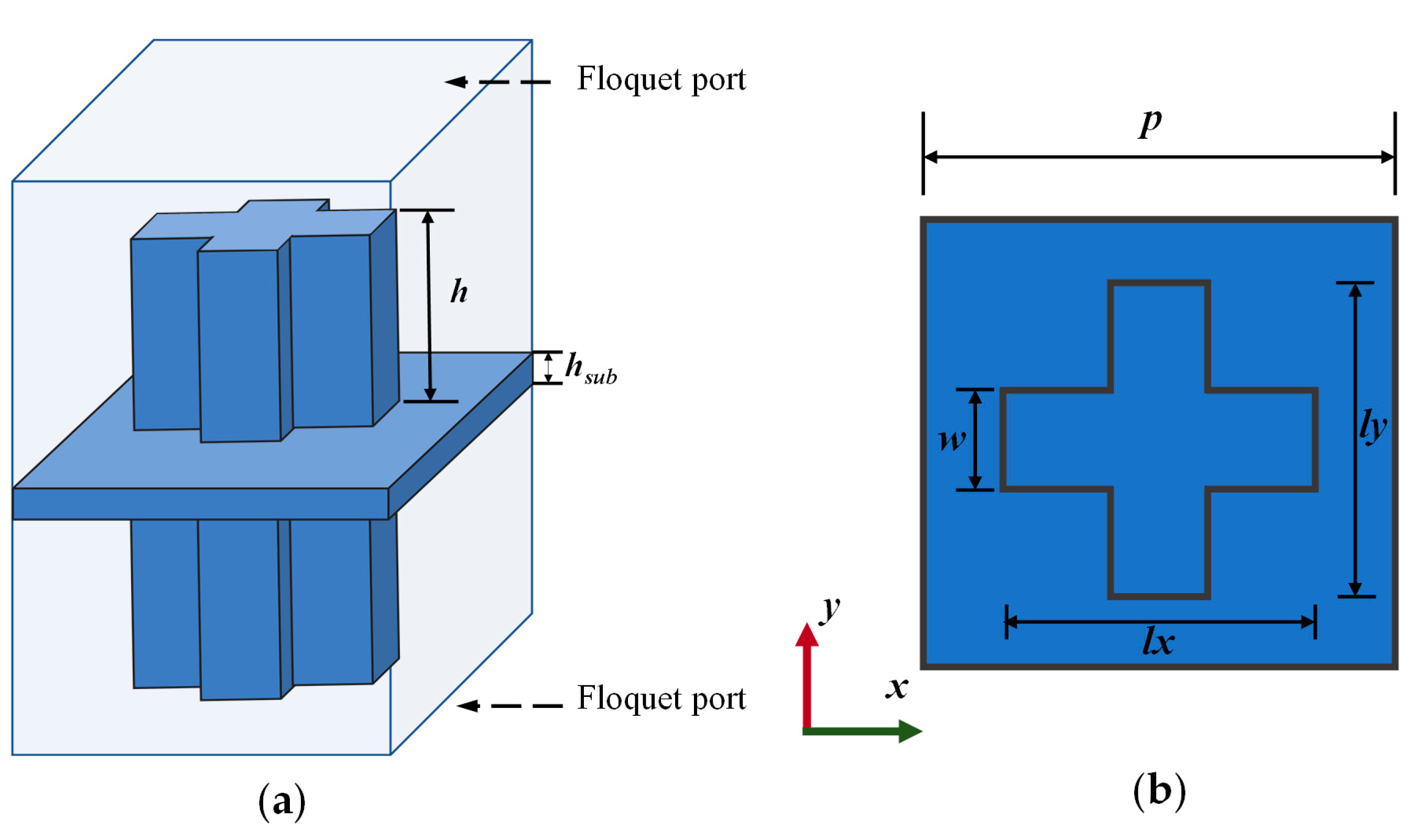


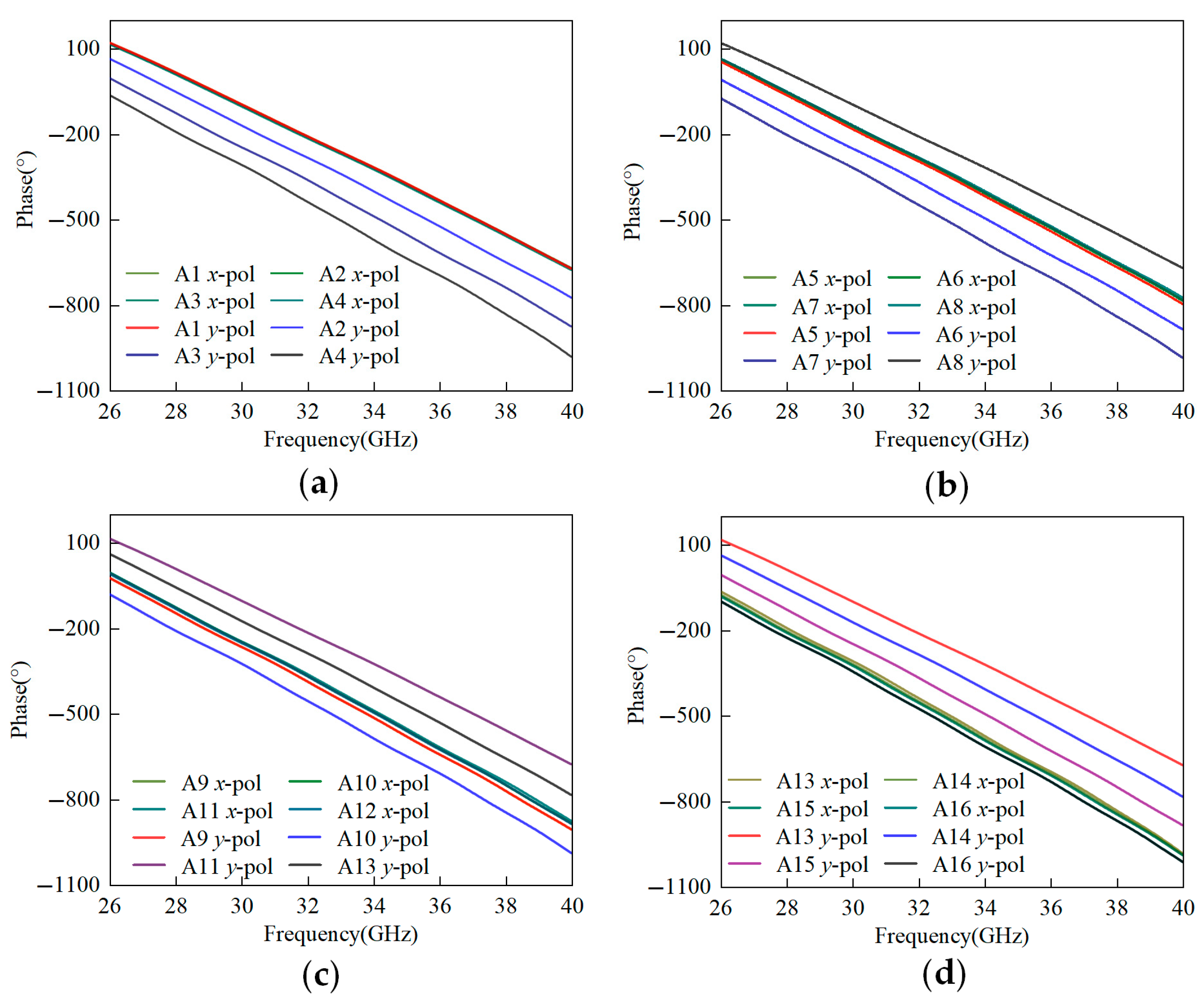
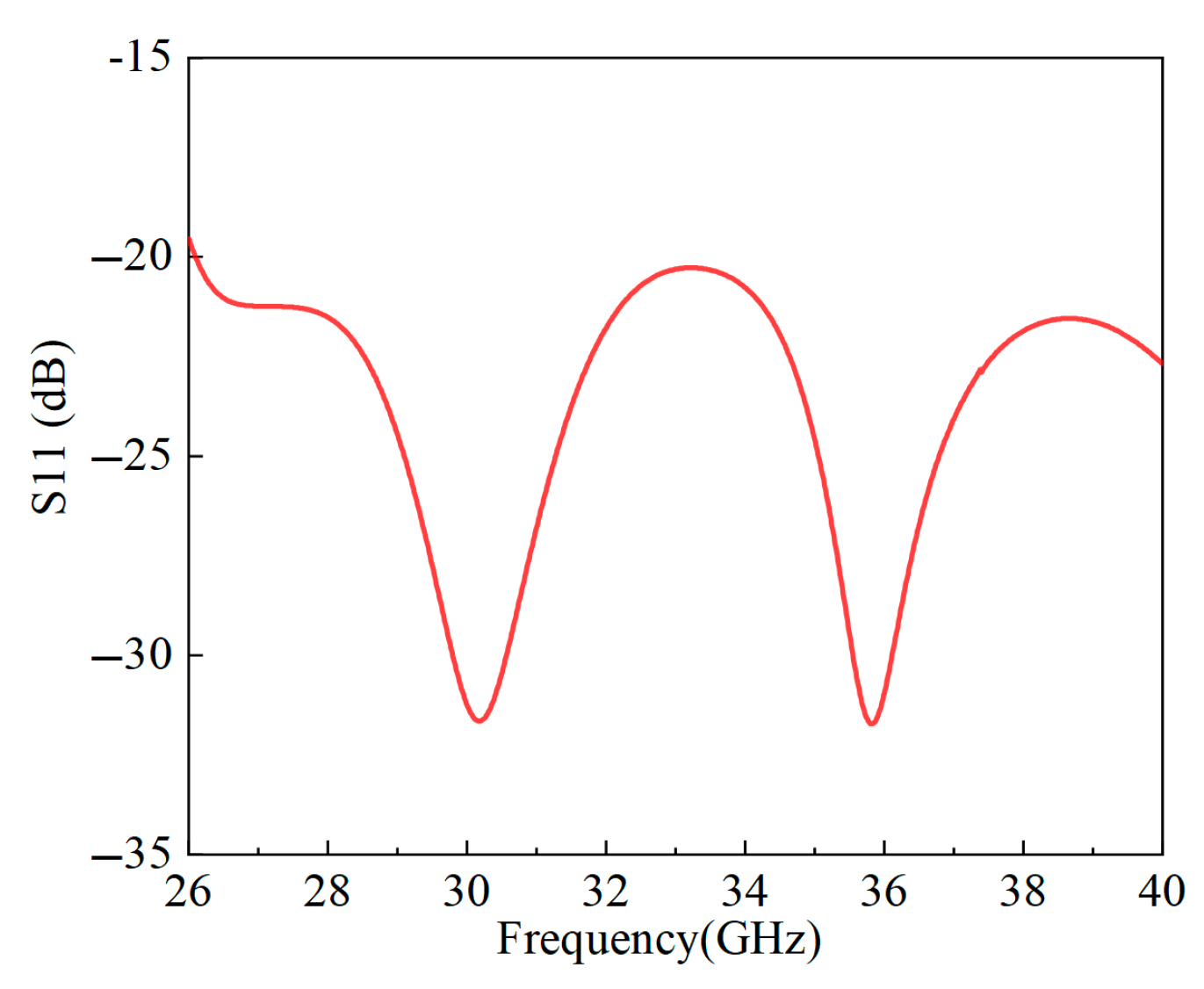


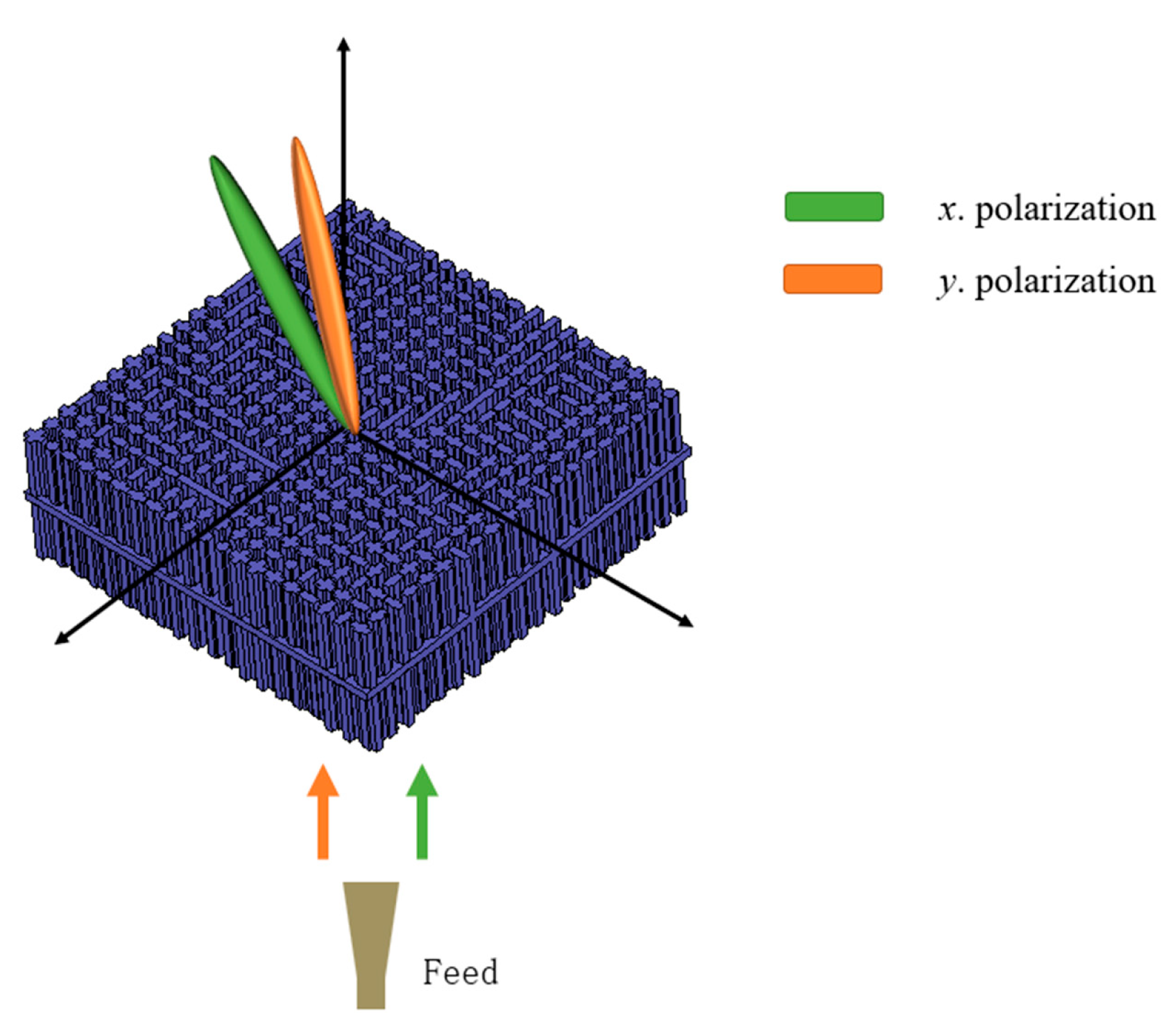
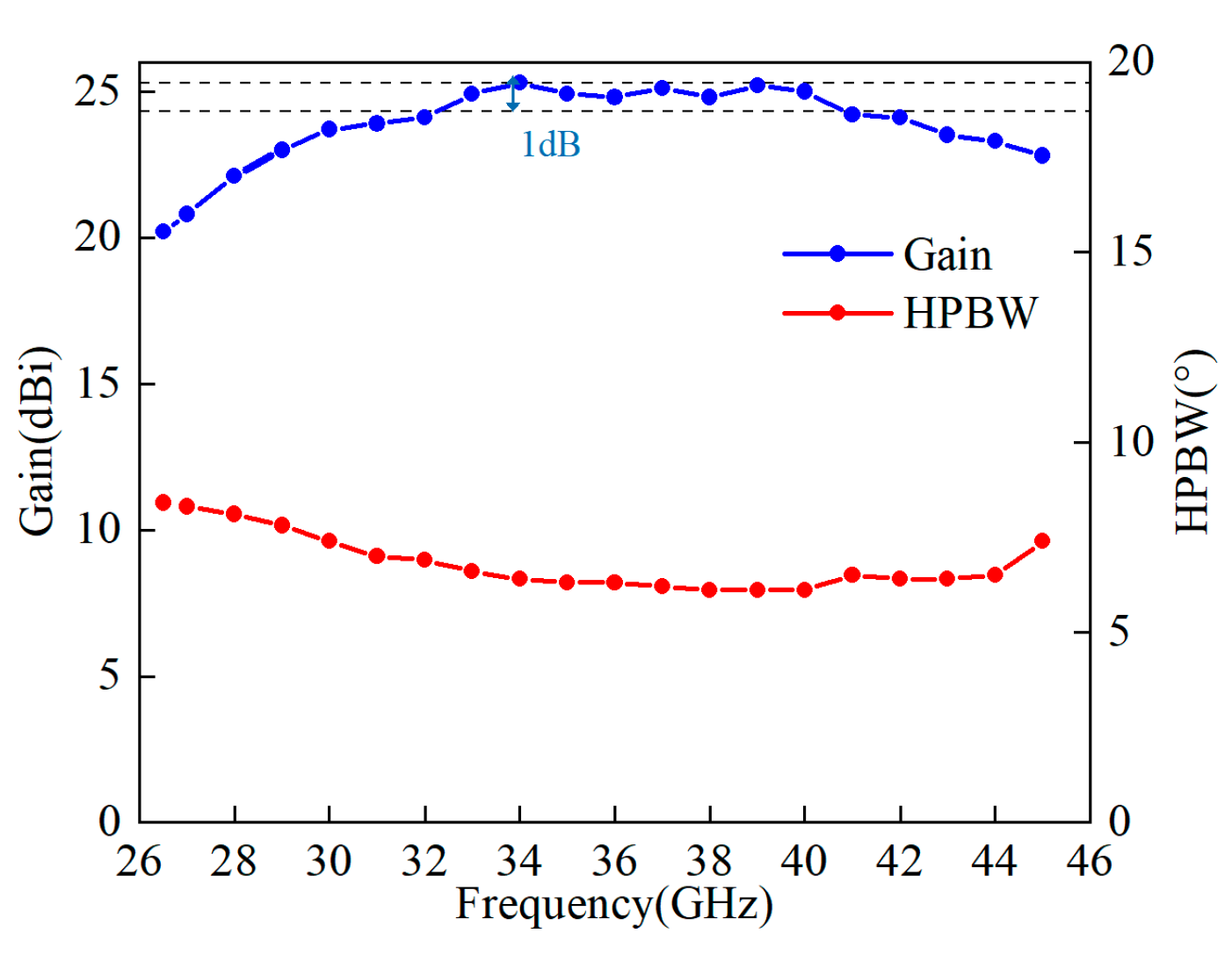
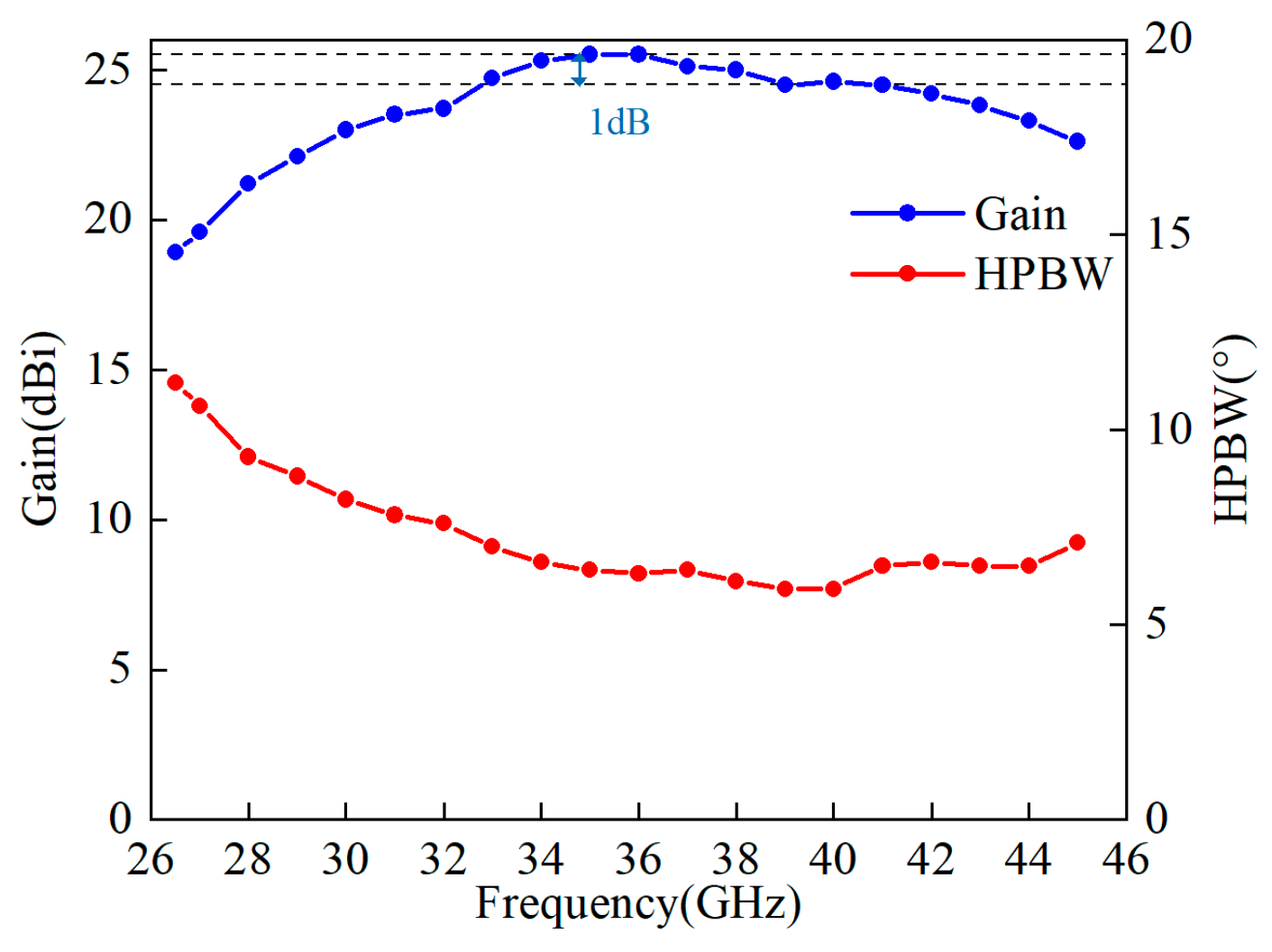
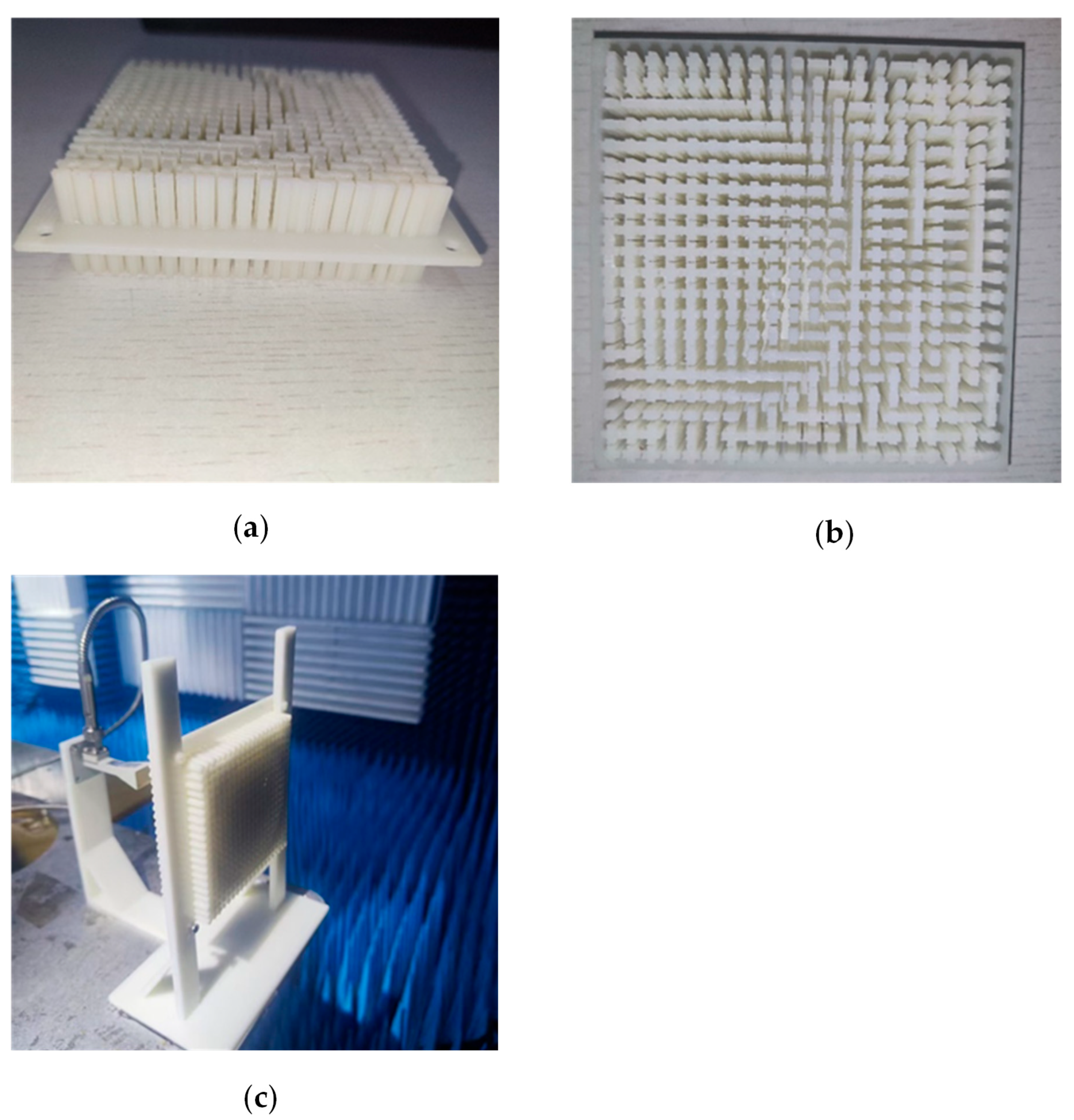
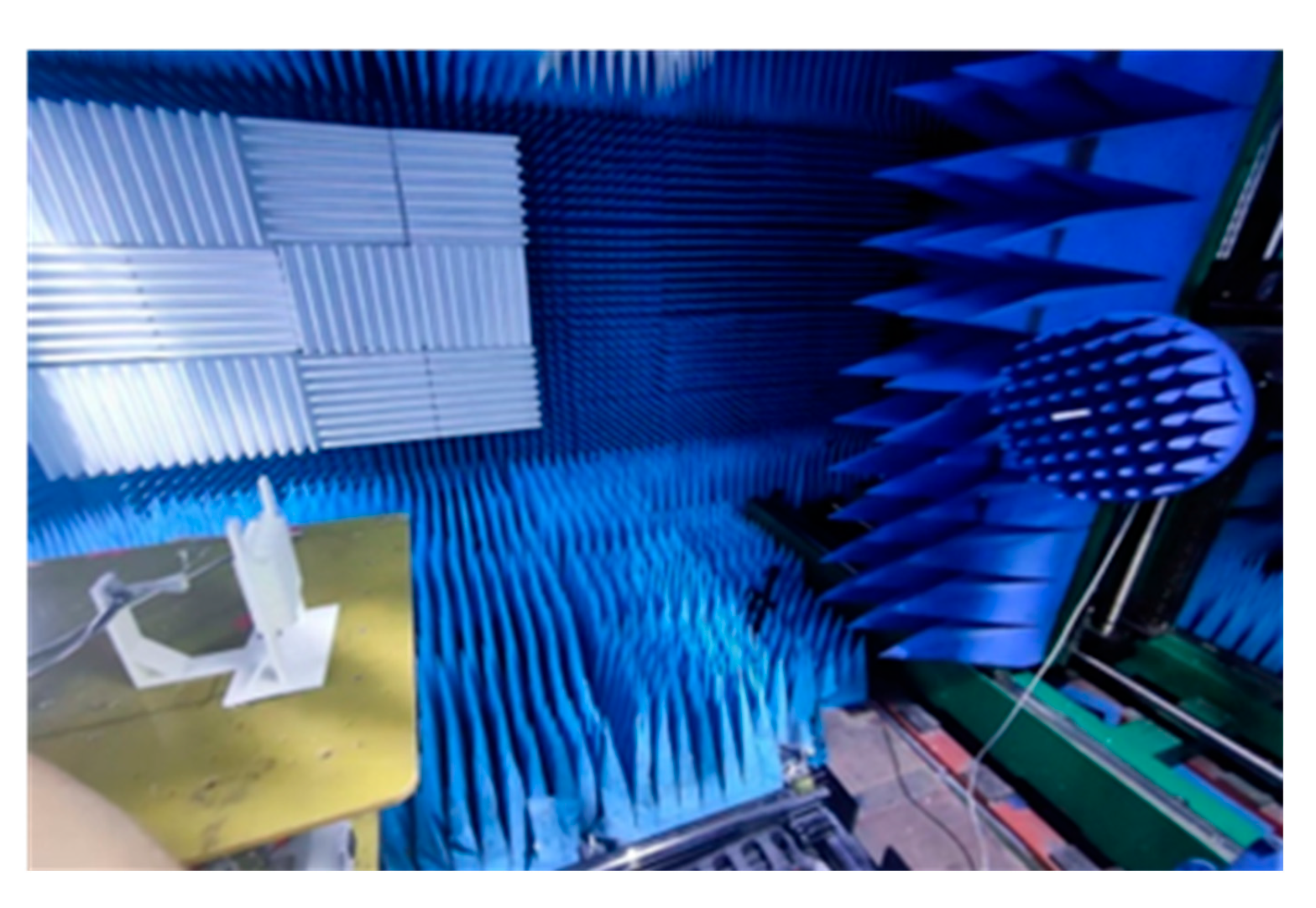


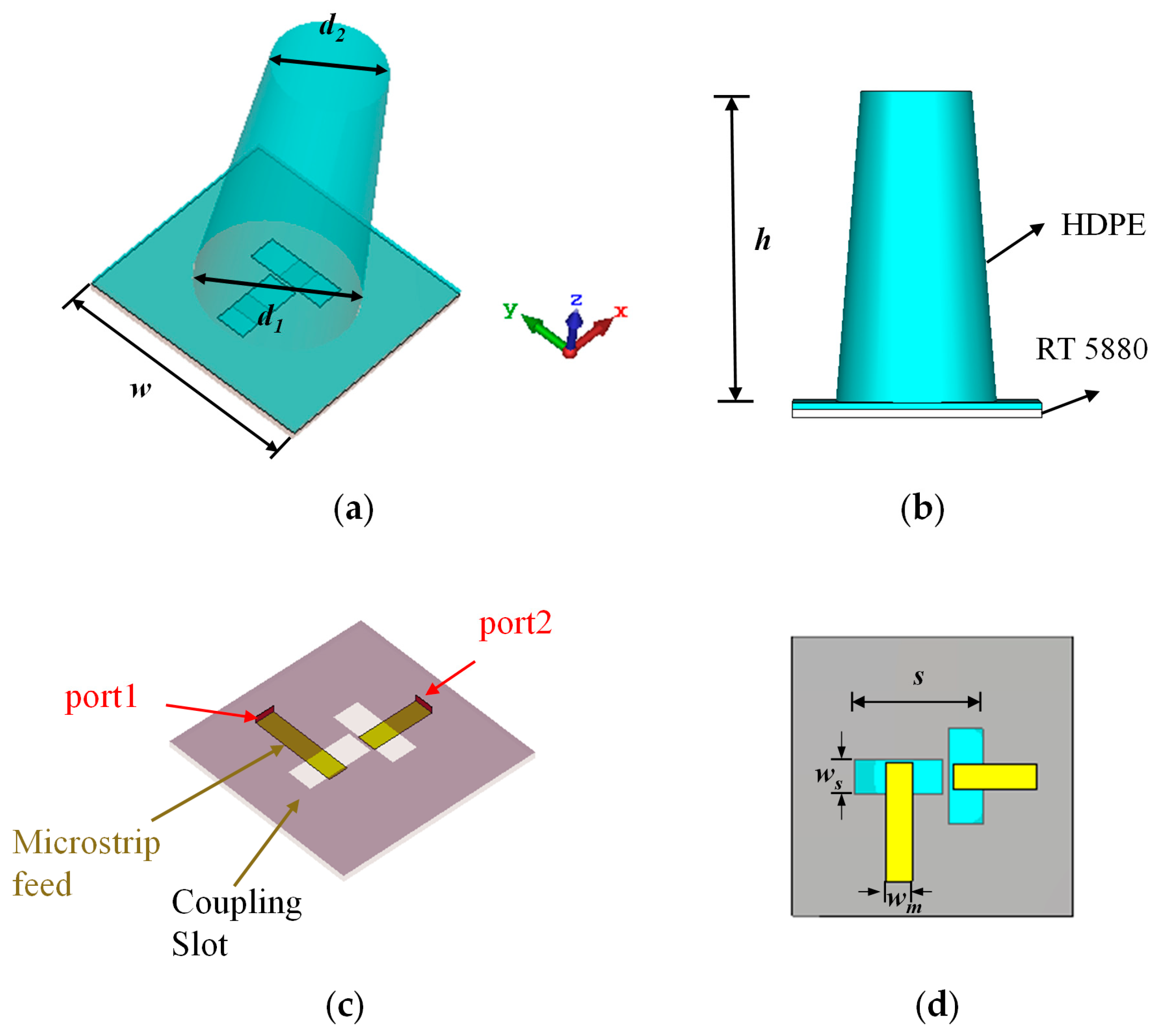


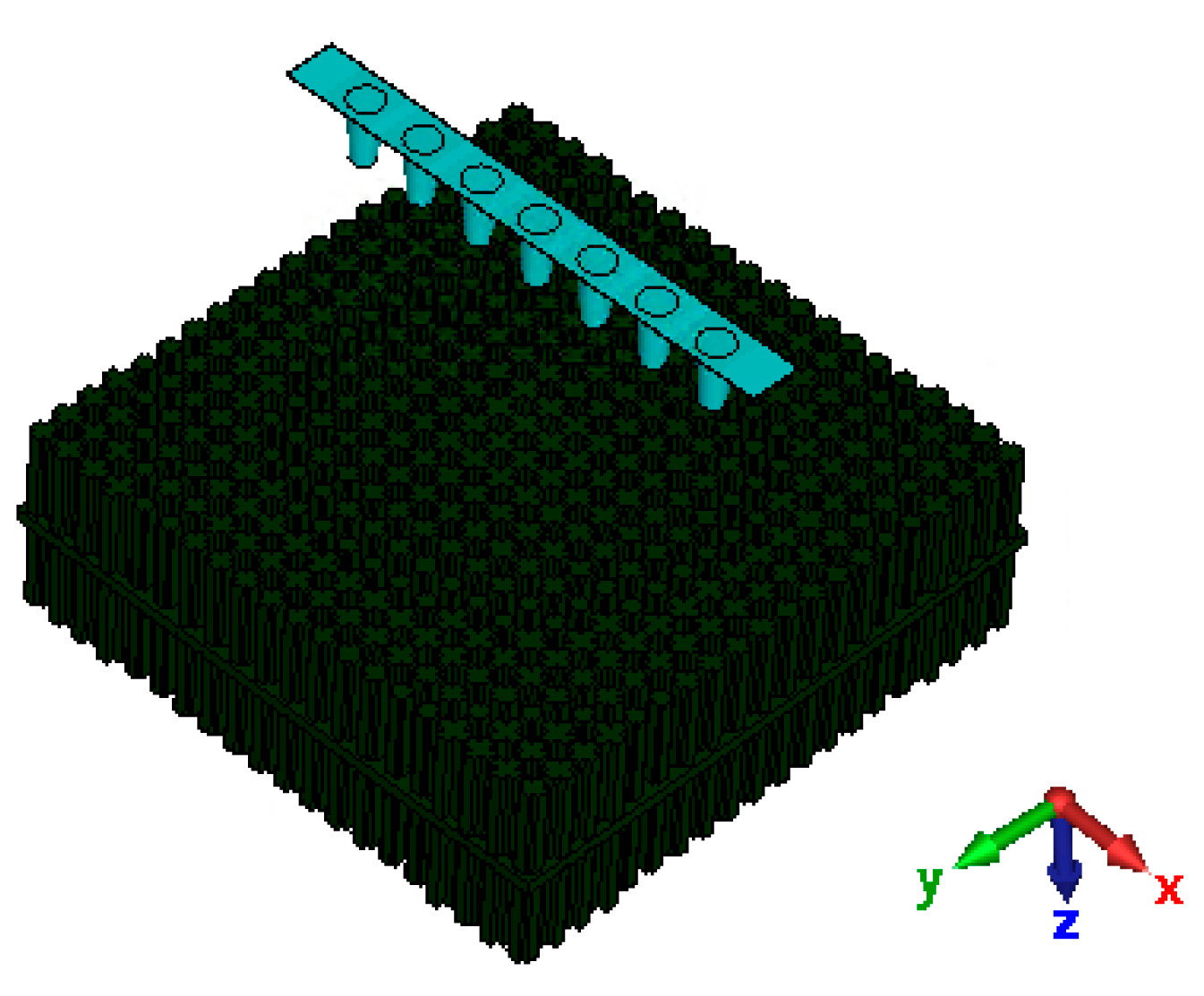

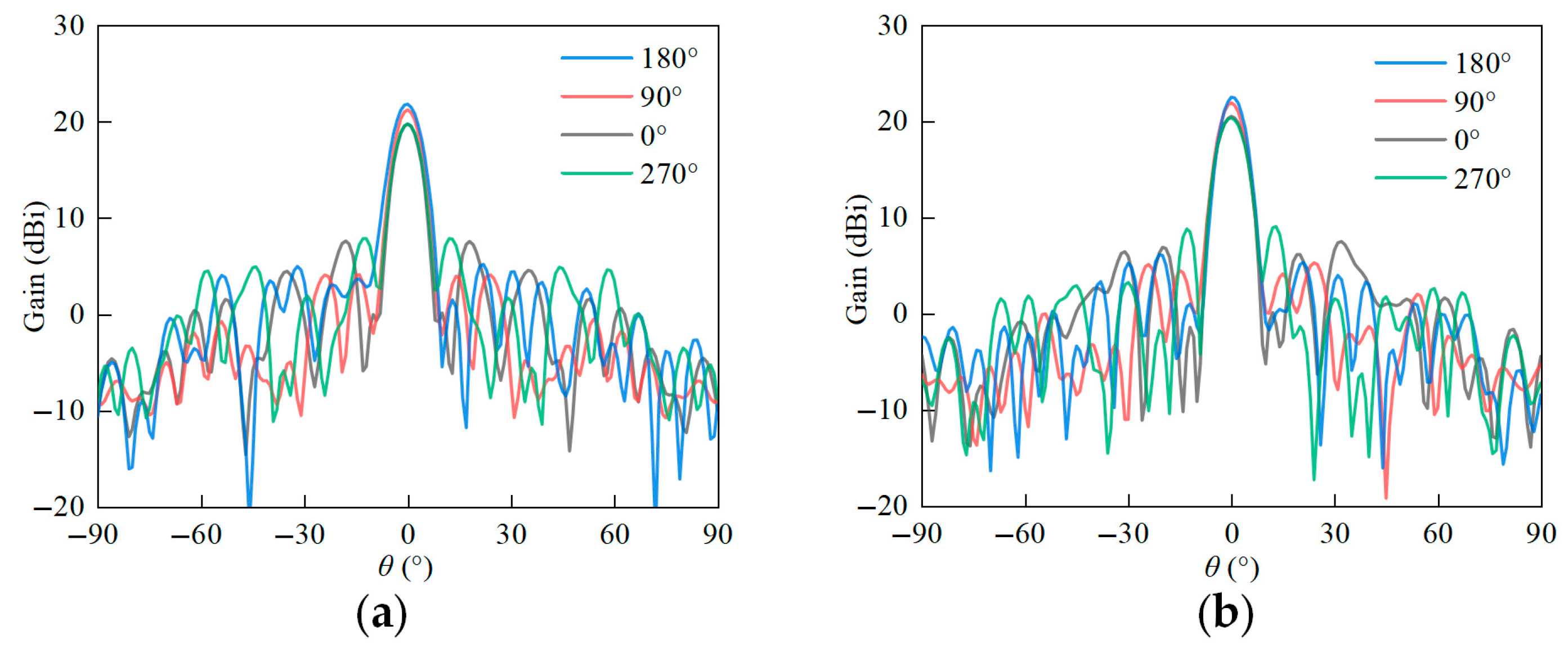
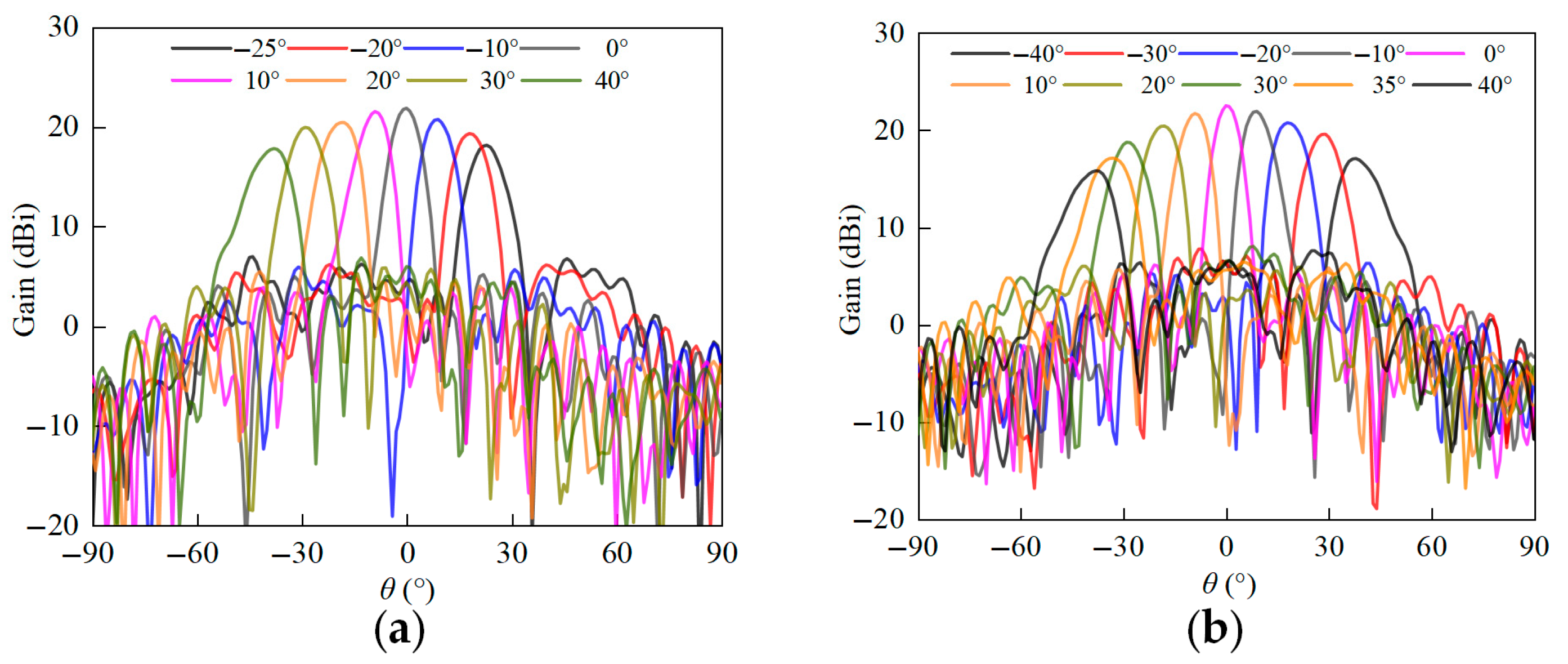
| Parameter | Value (mm) |
|---|---|
| p | 4.5 |
| h | 12 |
| w | 1.7 |
| hsub | 2 |
| Unit | lx (mm) | ly (mm) | Theoretical x-Pol Phase (°) | Theoretical y-Pol Phase (°) | Actual x-Pol Phase (°) | Actual y-Pol Phase (°) |
|---|---|---|---|---|---|---|
| A1 | 2.6 | 2.6 | 270 | 270 | 264 | 264 |
| A2 | 3.4 | 3.2 | 270 | 180 | 262 | 190 |
| A3 | 4.1 | 2.1 | 270 | 90 | 256 | 103 |
| A4 | 4.5 | 1.9 | 270 | 0 | 260 | 22 |
| A5 | 2.3 | 3.4 | 180 | 270 | 190 | 262 |
| A6 | 3.2 | 3.2 | 180 | 180 | 176 | 176 |
| A7 | 3.9 | 2.9 | 180 | 90 | 185 | 108 |
| A8 | 4.4 | 2.7 | 180 | 0 | 188 | 21 |
| A9 | 2.1 | 4.1 | 90 | 270 | 103 | 256 |
| A10 | 2.9 | 3.9 | 90 | 180 | 108 | 186 |
| A11 | 3.8 | 3.8 | 90 | 90 | 94 | 94 |
| A12 | 4.3 | 3.5 | 90 | 0 | 108 | 26 |
| A13 | 1.9 | 4.5 | 0 | 270 | 22 | 261 |
| A14 | 2.7 | 4.4 | 0 | 180 | 21 | 188 |
| A15 | 3.5 | 4.3 | 0 | 90 | 26 | 112 |
| A16 | 4.3 | 4.3 | 0 | 0 | 15 | 15 |
| Parameter | Value (mm) | Parameter | Value (mm) |
|---|---|---|---|
| Aperture Length | 7 | Horn Opening Length | 17 |
| Aperture Width | 3.5 | Horn Opening Width | 12 |
| Waveguide Length | 31 | Axial Length of Horn | 20 |
| Ref | Frequency (GHz) | Number of Elements | Gain (dBi) | Aperture Efficiency | 1 dB Gain Bandwidth |
|---|---|---|---|---|---|
| [45] | 11.5 | 10 × 10 | 18.3 | 22.6% | 11.5% |
| [46] | 27 | 16 × 16 | 24 | 31% | 23% |
| [47] | 10 | 20 × 20 | 25.3 | 24% | 19% |
| [48] | 5.4 | 8 × 8 | 17 | 28% | 9% |
| This work | 34 | 20 × 20 | 25.5 | 25.7% | 27% |
| Parameter | Value (mm) |
|---|---|
| w | 8 |
| h | 10 |
| d1 | 5.2 |
| d2 | 3.6 |
| s | 3.66 |
| ws | 1 |
| wm | 0.74 |
Disclaimer/Publisher’s Note: The statements, opinions and data contained in all publications are solely those of the individual author(s) and contributor(s) and not of MDPI and/or the editor(s). MDPI and/or the editor(s) disclaim responsibility for any injury to people or property resulting from any ideas, methods, instructions or products referred to in the content. |
© 2025 by the authors. Licensee MDPI, Basel, Switzerland. This article is an open access article distributed under the terms and conditions of the Creative Commons Attribution (CC BY) license (https://creativecommons.org/licenses/by/4.0/).
Share and Cite
Liu, B.; Sun, H.; Jiang, X.; Hu, J.; Deng, C. Design of Dual-Polarized All-Dielectric Transmitarray Antenna for Ka-Band Applications. Appl. Sci. 2025, 15, 9560. https://doi.org/10.3390/app15179560
Liu B, Sun H, Jiang X, Hu J, Deng C. Design of Dual-Polarized All-Dielectric Transmitarray Antenna for Ka-Band Applications. Applied Sciences. 2025; 15(17):9560. https://doi.org/10.3390/app15179560
Chicago/Turabian StyleLiu, Baixin, Haixin Sun, Xujia Jiang, Jiayu Hu, and Changjiang Deng. 2025. "Design of Dual-Polarized All-Dielectric Transmitarray Antenna for Ka-Band Applications" Applied Sciences 15, no. 17: 9560. https://doi.org/10.3390/app15179560
APA StyleLiu, B., Sun, H., Jiang, X., Hu, J., & Deng, C. (2025). Design of Dual-Polarized All-Dielectric Transmitarray Antenna for Ka-Band Applications. Applied Sciences, 15(17), 9560. https://doi.org/10.3390/app15179560







